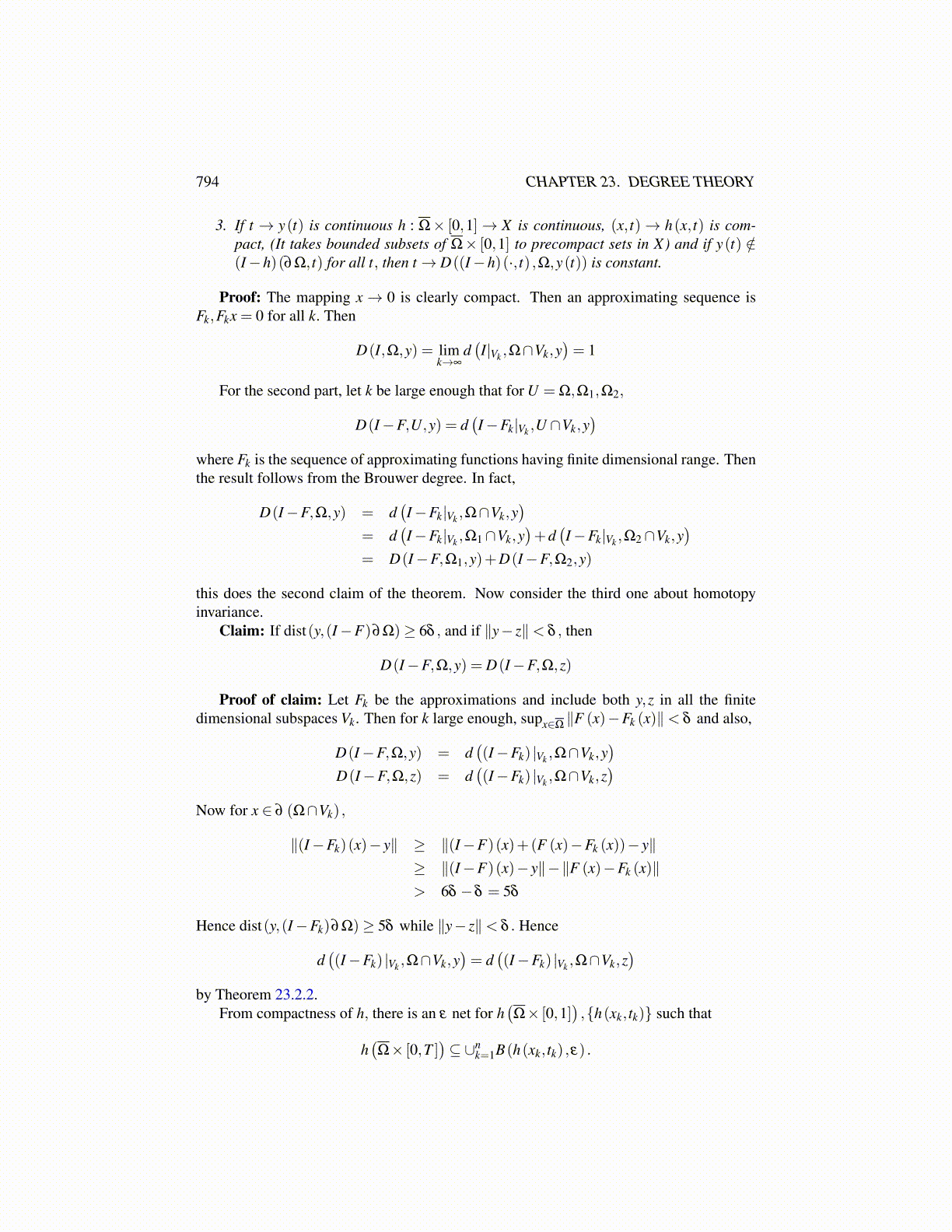
794 CHAPTER 23. DEGREE THEORY
The main properties of the Leray Schauder degree follow from the corresponding prop-erties of Brouwer degree.
Theorem 23.9.6 Let D be the Leray Schauder degree just defined and let Ω be a boundedopen set y /∈ (I−F)(∂Ω) where F is always a compact mapping. Then the followingproperties hold:
1. D(I,Ω,y) = 1
2. If Ωi ⊆Ω where Ωi is open, Ω1∩Ω2 = /0, and y /∈Ω\ (Ω1∪Ω2) then
D(I−F,Ω,y) = D(I−F,Ω1,y)+D(I−F,Ω2,y)
3. If t → y(t) is continuous h : Ω× [0,1]→ X is continuous, (x, t)→ h(x, t) is com-pact, (It takes bounded subsets of Ω× [0,1] to precompact sets in X) and if y(t) /∈(I−h)(∂Ω, t) for all t, then t→ D((I−h)(·, t) ,Ω,y(t)) is constant.
Proof: The mapping x→ 0 is clearly compact. Then an approximating sequence isFk,Fkx = 0 for all k. Then
D(I,Ω,y) = limk→∞
d(I|Vk ,Ω∩Vk,y
)= 1
For the second part, let k be large enough that for U = Ω,Ω1,Ω2,
D(I−F,U,y) = d(I−Fk|Vk ,U ∩Vk,y
)where Fk is the sequence of approximating functions having finite dimensional range. Thenthe result follows from the Brouwer degree. In fact,
D(I−F,Ω,y) = d(I−Fk|Vk ,Ω∩Vk,y
)= d
(I−Fk|Vk ,Ω1∩Vk,y
)+d(I−Fk|Vk ,Ω2∩Vk,y
)= D(I−F,Ω1,y)+D(I−F,Ω2,y)
this does the second claim of the theorem. Now consider the third one about homotopyinvariance.
Claim: If dist(y,(I−F)∂Ω)≥ 6δ , and if ∥y− z∥< δ , then
D(I−F,Ω,y) = D(I−F,Ω,z)
Proof of claim: Let Fk be the approximations and include both y,z in all the finitedimensional subspaces Vk. Then for k large enough, supx∈Ω
∥F (x)−Fk (x)∥< δ and also,
D(I−F,Ω,y) = d((I−Fk) |Vk ,Ω∩Vk,y
)D(I−F,Ω,z) = d
((I−Fk) |Vk ,Ω∩Vk,z
)Now for x ∈ ∂ (Ω∩Vk) ,
∥(I−Fk)(x)− y∥ ≥ ∥(I−F)(x)+(F (x)−Fk (x))− y∥≥ ∥(I−F)(x)− y∥−∥F (x)−Fk (x)∥> 6δ −δ = 5δ